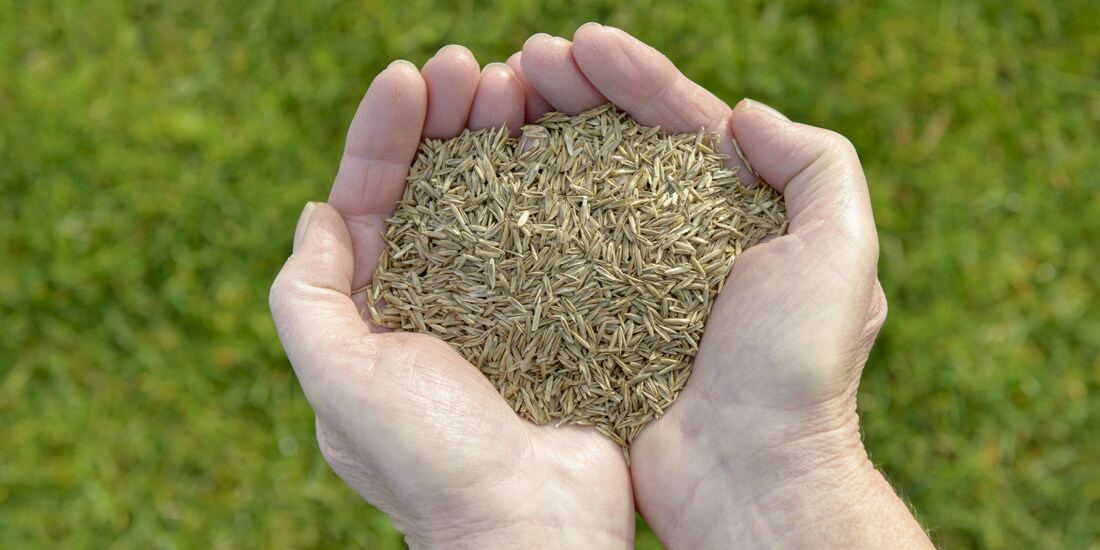How do you overseed a lawn?

Is your lawn looking patchy, thin or tired due to the pressure of the UK winter months? Maybe your lawn is showing wear and tear due to all the fun your kids and pets have been having now that the better weather has arrived - or did you just not have time to keep on top of your lawn care towards the end of last year? Whatever the reason, overseeding is one of the best ways to repair damaged areas of your lawn, giving you luscious green grass and ultimately bringing your lawn back to life!
How do you overseed a lawn?
The answer is that the procedure of lawn overseeding is a simple step-by-step process of lawn preparation, moistening the soil and then evenly sprinkling your top-quality grass seed over the top.
Aside from knowing what grass seed you need, the advice below details the steps required to overseed a lawn successfully.
When should I be overseeding a lawn?
To get the best results from overseeding, we are looking for the weather when the temperature is mild yet still tends to bring along plenty of rainy days, such as during months of spring or autumn. For seeds to grow, they need the right conditions for germination. Grass seed germination relies on warm soil temperature, around 8-100C, and plenty of moisture.
Overseeding preparation tips
- Weed the lawn either by hand or using weed killer
- Remove any boulders, stones, etc.
- Scarify the soil to remove moss and loosen the soil
- Allow to settle for 10-14 days to encourage any dormant weeds to appear
- Remove any newly appearing weeds by hand
- Fertilise the soil with a quick-release fertiliser.
Overseeding preparation allows you to repair any damage to your lawn and will give you a fresh canvas from which to work. We suggest beginning preparations 1-2 weeks before reseeding. However, we realise life is busy, so if you plan on reseeding in one day, it can still be done with great results. We recommend you let the area cultivate for 10-14 days to encourage any underlying weeds to show their faces. You will need to weed the grass by hand, as using weed killer and sowing new seeds on the same day is a bad idea as the new grass could be damaged.
What about using grass fertiliser when overseeding?
Using a quick-release fertiliser will give your lawn the quick boost it needs in preparation for reseeding. It will help your lawn grow and fill out more quickly. To avoid grass blade burning, apply fertiliser evenly on an overcast day or in the evening when it’s not too hot. Ensure you water off the fertiliser from the grass blades after application, or to save a little time, apply a granular fertiliser just before rainfall.
Applying your seeds when overseeding a lawn
- Start by mowing your grass to approximately 25mm in length
- Moisten the soil
- Sprinkle the seed onto the grass evenly - apply more in patchy or thinner areas.
As standard, the seeds should be applied at a rate of 35g per square metre. However, if patchy areas are present, apply the seed at a rate of 50g per square metre. Consider the depth of soil your seed will sit in. If you bury it too deep, the plant will run out of energy. If left on the surface, it may dry out, or birds may come along and eat it up—try to find a happy medium.
It also helps to use the best grass seeds suited to your garden's soil type.
Lawn overseeding finishing touches
- Water your lawn after reseeding.
- Roll the lawn (optional)
- Continue to mow the grass regularly with care and attention.
When watering the grass, little and often is best. We recommend you water your lawn every day after reseeding until your new grass is established, mainly if there has been only light rainfall or no rain. However, be aware not to drown the seed with overwatering. Also, allow your lawn to sprout and grow by protecting it from traffic for 2-3 weeks. For future mowing, cut at a height of approximately 50mm. Pay extra attention to the first cut after overseeding; your lawn is still getting established and needs a little extra care.
Overseeding a lawn for the best results year after year
Knowing how to overseed a lawn ensures you have a thick and healthy-looking lawn that everyone can appreciate and enjoy. Overseeding a lawn is not difficult; when done correctly, it brings noticeable results within only a few weeks! We have included a few links below to other lawn care guides for further reading to help you get more from your garden lawn: